2010 FORD F150 service
[x] Cancel search: servicePage 32 of 57
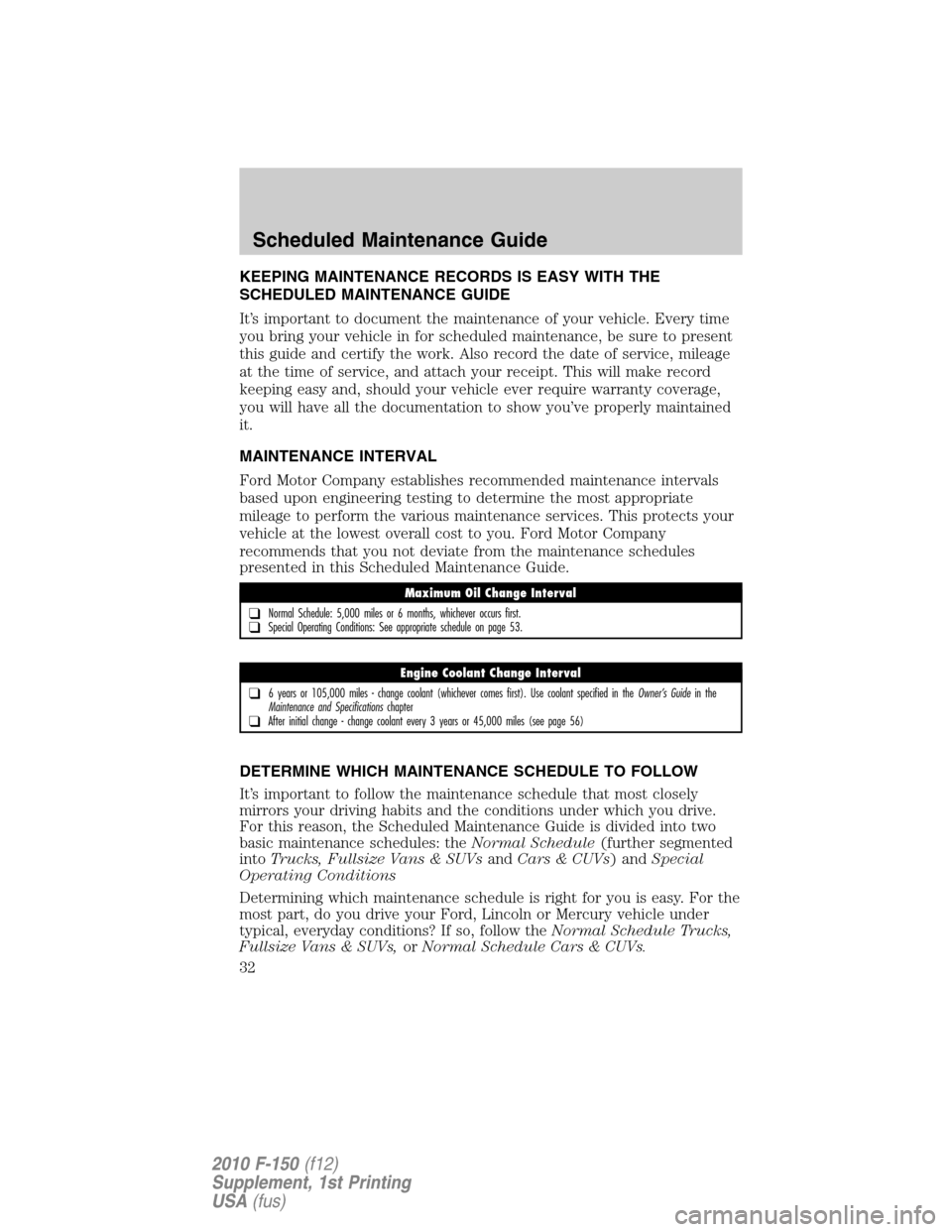
KEEPING MAINTENANCE RECORDS IS EASY WITH THE
SCHEDULED MAINTENANCE GUIDE
It’s important to document the maintenance of your vehicle. Every time
you bring your vehicle in for scheduled maintenance, be sure to present
this guide and certify the work. Also record the date of service, mileage
at the time of service, and attach your receipt. This will make record
keeping easy and, should your vehicle ever require warranty coverage,
you will have all the documentation to show you’ve properly maintained
it.
MAINTENANCE INTERVAL
Ford Motor Company establishes recommended maintenance intervals
based upon engineering testing to determine the most appropriate
mileage to perform the various maintenance services. This protects your
vehicle at the lowest overall cost to you. Ford Motor Company
recommends that you not deviate from the maintenance schedules
presented in this Scheduled Maintenance Guide.
DETERMINE WHICH MAINTENANCE SCHEDULE TO FOLLOW
It’s important to follow the maintenance schedule that most closely
mirrors your driving habits and the conditions under which you drive.
For this reason, the Scheduled Maintenance Guide is divided into two
basic maintenance schedules: theNormal Schedule(further segmented
intoTrucks, Fullsize Vans & SUVsandCars & CUVs) andSpecial
Operating Conditions
Determining which maintenance schedule is right for you is easy. For the
most part, do you drive your Ford, Lincoln or Mercury vehicle under
typical, everyday conditions? If so, follow theNormal Schedule Trucks,
Fullsize Vans & SUVs,orNormal Schedule Cars & CUVs.
Maximum Oil Change Interval
❑Normal Schedule: 5,000 miles or 6 months, whichever occurs first.❑Special Operating Conditions: See appropriate schedule on page 53.
Engine Coolant Change Interval
❑6 years or 105,000 miles - change coolant (whichever comes first). Use coolant specified in theOwner’s Guidein theMaintenance and Specificationschapter❑After initial change - change coolant every 3 years or 45,000 miles (see page 56)
Scheduled Maintenance Guide
32
2010 F-150(f12)
Supplement, 1st Printing
USA(fus)
Page 33 of 57
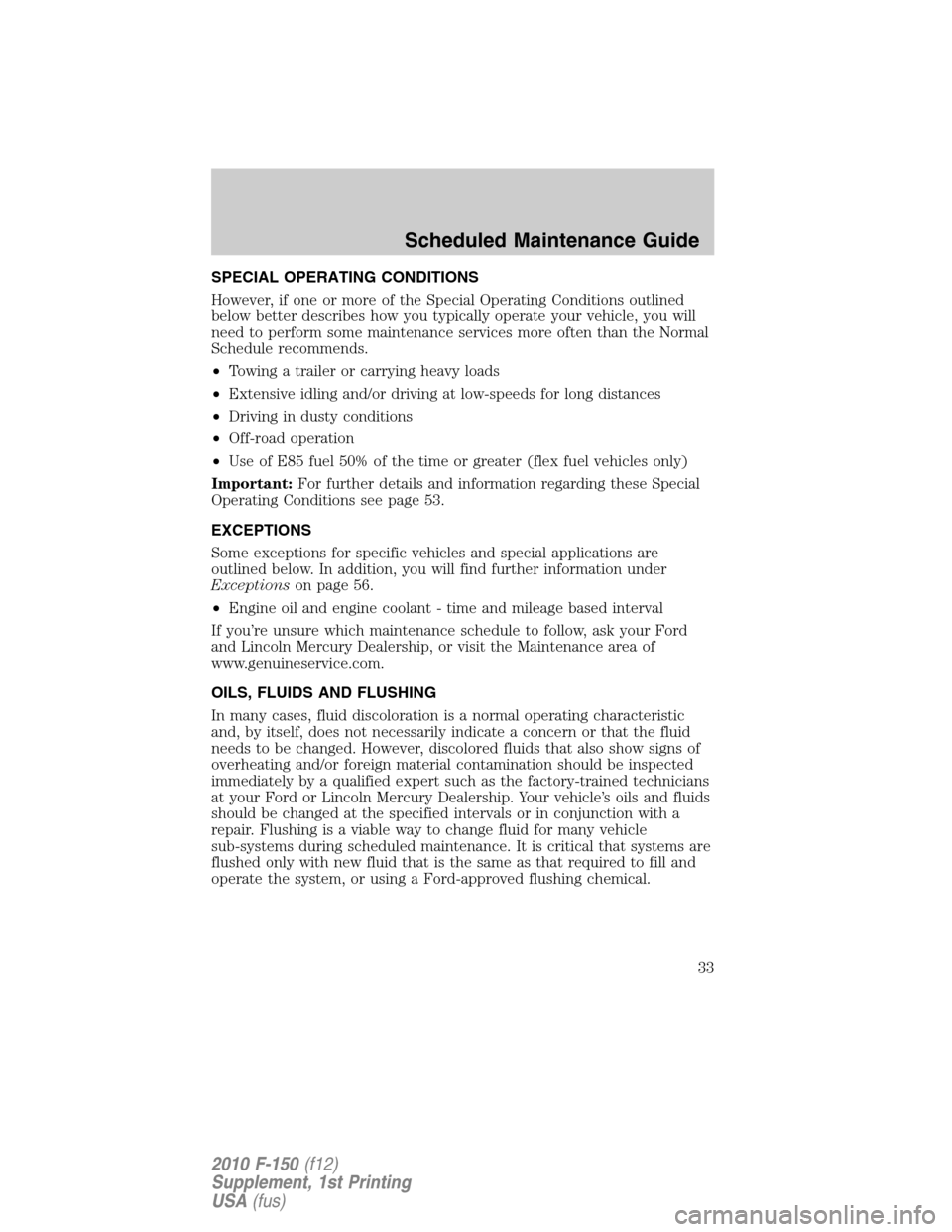
SPECIAL OPERATING CONDITIONS
However, if one or more of the Special Operating Conditions outlined
below better describes how you typically operate your vehicle, you will
need to perform some maintenance services more often than the Normal
Schedule recommends.
•Towing a trailer or carrying heavy loads
•Extensive idling and/or driving at low-speeds for long distances
•Driving in dusty conditions
•Off-road operation
•Use of E85 fuel 50% of the time or greater (flex fuel vehicles only)
Important:For further details and information regarding these Special
Operating Conditions see page 53.
EXCEPTIONS
Some exceptions for specific vehicles and special applications are
outlined below. In addition, you will find further information under
Exceptionson page 56.
•Engine oil and engine coolant - time and mileage based interval
If you’re unsure which maintenance schedule to follow, ask your Ford
and Lincoln Mercury Dealership, or visit the Maintenance area of
www.genuineservice.com.
OILS, FLUIDS AND FLUSHING
In many cases, fluid discoloration is a normal operating characteristic
and, by itself, does not necessarily indicate a concern or that the fluid
needs to be changed. However, discolored fluids that also show signs of
overheating and/or foreign material contamination should be inspected
immediately by a qualified expert such as the factory-trained technicians
at your Ford or Lincoln Mercury Dealership. Your vehicle’s oils and fluids
should be changed at the specified intervals or in conjunction with a
repair. Flushing is a viable way to change fluid for many vehicle
sub-systems during scheduled maintenance. It is critical that systems are
flushed only with new fluid that is the same as that required to fill and
operate the system, or using a Ford-approved flushing chemical.
Scheduled Maintenance Guide
33
2010 F-150(f12)
Supplement, 1st Printing
USA(fus)
Page 34 of 57
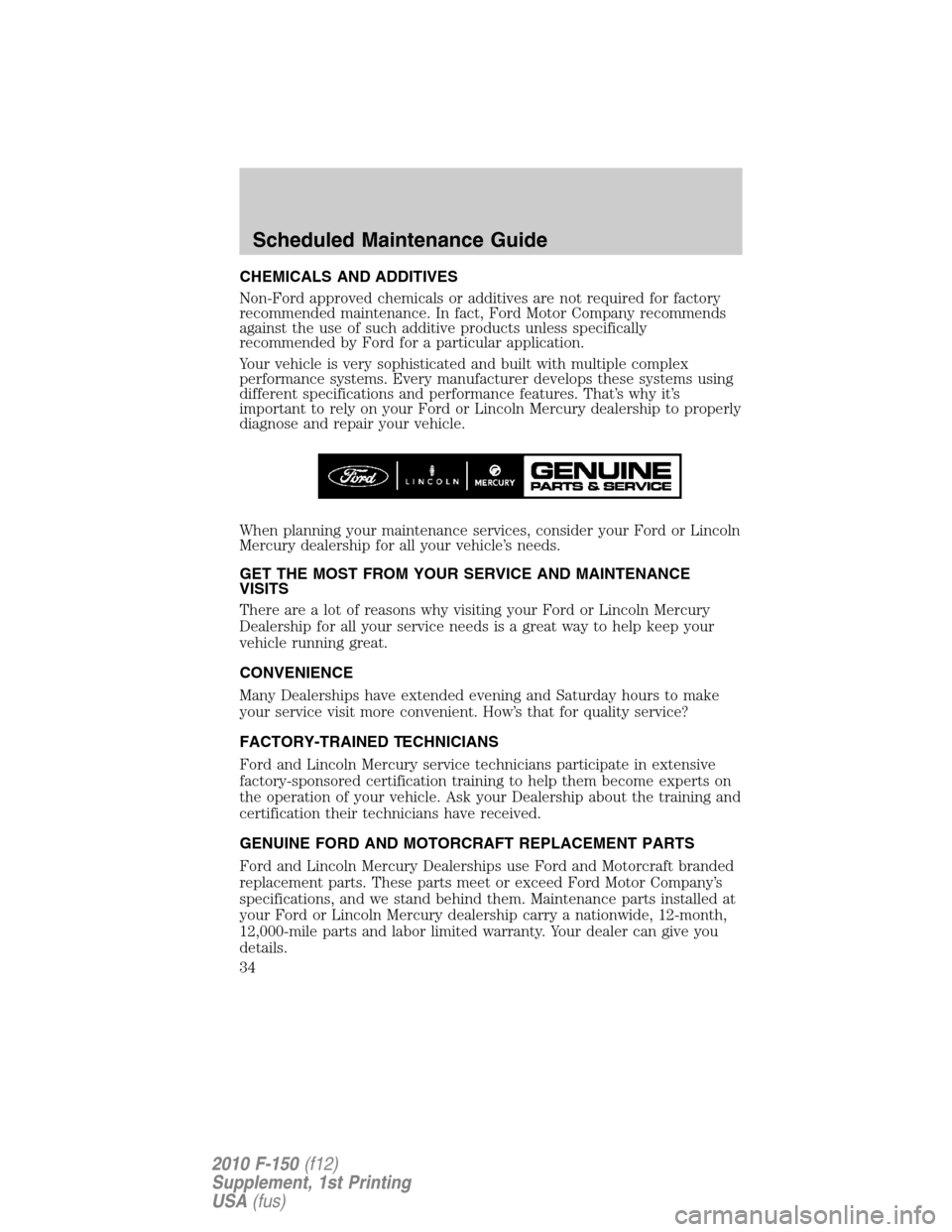
CHEMICALS AND ADDITIVES
Non-Ford approved chemicals or additives are not required for factory
recommended maintenance. In fact, Ford Motor Company recommends
against the use of such additive products unless specifically
recommended by Ford for a particular application.
Your vehicle is very sophisticated and built with multiple complex
performance systems. Every manufacturer develops these systems using
different specifications and performance features. That’s why it’s
important to rely on your Ford or Lincoln Mercury dealership to properly
diagnose and repair your vehicle.
When planning your maintenance services, consider your Ford or Lincoln
Mercury dealership for all your vehicle’s needs.
GET THE MOST FROM YOUR SERVICE AND MAINTENANCE
VISITS
There are a lot of reasons why visiting your Ford or Lincoln Mercury
Dealership for all your service needs is a great way to help keep your
vehicle running great.
CONVENIENCE
Many Dealerships have extended evening and Saturday hours to make
your service visit more convenient. How’s that for quality service?
FACTORY-TRAINED TECHNICIANS
Ford and Lincoln Mercury service technicians participate in extensive
factory-sponsored certification training to help them become experts on
the operation of your vehicle. Ask your Dealership about the training and
certification their technicians have received.
GENUINE FORD AND MOTORCRAFT REPLACEMENT PARTS
Ford and Lincoln Mercury Dealerships use Ford and Motorcraft branded
replacement parts. These parts meet or exceed Ford Motor Company’s
specifications, and we stand behind them. Maintenance parts installed at
your Ford or Lincoln Mercury dealership carry a nationwide, 12-month,
12,000-mile parts and labor limited warranty. Your dealer can give you
details.
Scheduled Maintenance Guide
34
2010 F-150(f12)
Supplement, 1st Printing
USA(fus)
Page 35 of 57
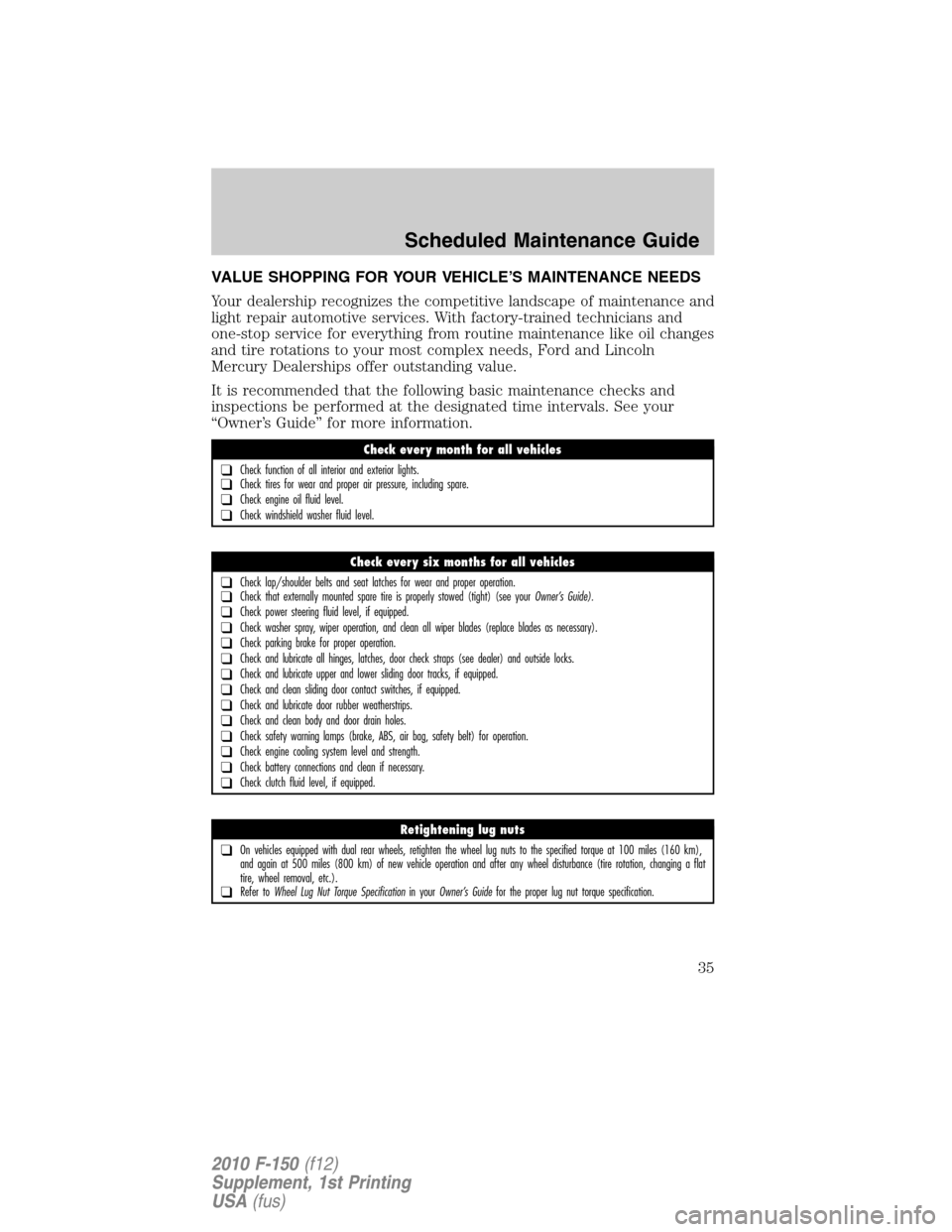
VALUE SHOPPING FOR YOUR VEHICLE’S MAINTENANCE NEEDS
Your dealership recognizes the competitive landscape of maintenance and
light repair automotive services. With factory-trained technicians and
one-stop service for everything from routine maintenance like oil changes
and tire rotations to your most complex needs, Ford and Lincoln
Mercury Dealerships offer outstanding value.
It is recommended that the following basic maintenance checks and
inspections be performed at the designated time intervals. See your
“Owner’s Guide” for more information.
Check every month for all vehicles
❑Check function of all interior and exterior lights.❑Check tires for wear and proper air pressure, including spare.
❑Check engine oil fluid level.
❑Check windshield washer fluid level.
Check every six months for all vehicles
❑Check lap/shoulder belts and seat latches for wear and proper operation.❑Check that externally mounted spare tire is properly stowed (tight) (see yourOwner’s Guide).
❑Check power steering fluid level, if equipped.
❑Check washer spray, wiper operation, and clean all wiper blades (replace blades as necessary).
❑Check parking brake for proper operation.
❑Check and lubricate all hinges, latches, door check straps (see dealer) and outside locks.
❑Check and lubricate upper and lower sliding door tracks, if equipped.
❑Check and clean sliding door contact switches, if equipped.
❑Check and lubricate door rubber weatherstrips.
❑Check and clean body and door drain holes.
❑Check safety warning lamps (brake, ABS, air bag, safety belt) for operation.
❑Check engine cooling system level and strength.
❑Check battery connections and clean if necessary.
❑Check clutch fluid level, if equipped.
Retightening lug nuts
❑On vehicles equipped with dual rear wheels, retighten the wheel lug nuts to the specified torque at 100 miles (160 km),
and again at 500 miles (800 km) of new vehicle operation and after any wheel disturbance (tire rotation, changing a flat
tire, wheel removal, etc.).
❑Refer toWheel Lug Nut Torque Specificationin yourOwner’s Guidefor the proper lug nut torque specification.
Scheduled Maintenance Guide
35
2010 F-150(f12)
Supplement, 1st Printing
USA(fus)
Page 37 of 57
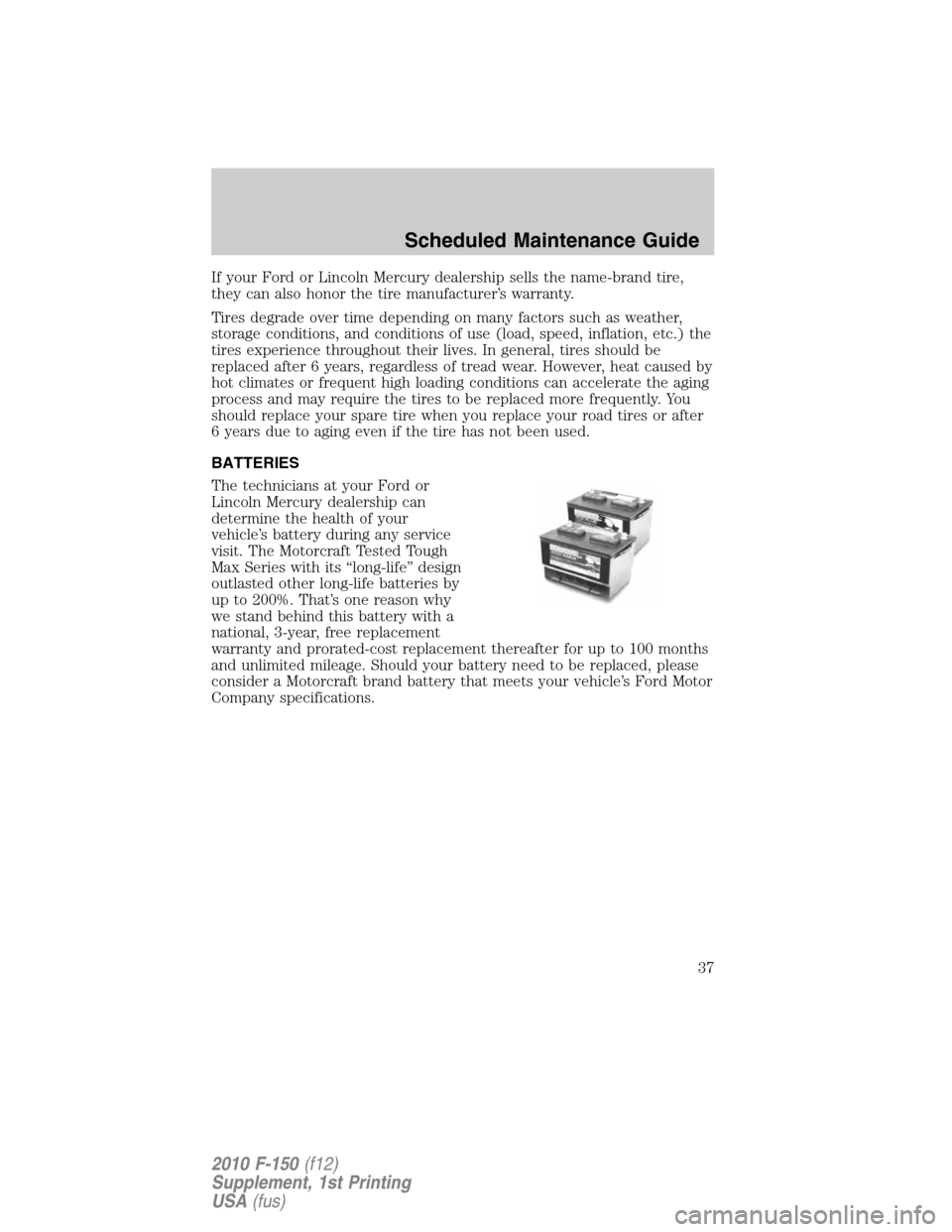
If your Ford or Lincoln Mercury dealership sells the name-brand tire,
they can also honor the tire manufacturer’s warranty.
Tires degrade over time depending on many factors such as weather,
storage conditions, and conditions of use (load, speed, inflation, etc.) the
tires experience throughout their lives. In general, tires should be
replaced after 6 years, regardless of tread wear. However, heat caused by
hot climates or frequent high loading conditions can accelerate the aging
process and may require the tires to be replaced more frequently. You
should replace your spare tire when you replace your road tires or after
6 years due to aging even if the tire has not been used.
BATTERIES
The technicians at your Ford or
Lincoln Mercury dealership can
determine the health of your
vehicle’s battery during any service
visit. The Motorcraft Tested Tough
Max Series with its “long-life” design
outlasted other long-life batteries by
up to 200%. That’s one reason why
we stand behind this battery with a
national, 3-year, free replacement
warranty and prorated-cost replacement thereafter for up to 100 months
and unlimited mileage. Should your battery need to be replaced, please
consider a Motorcraft brand battery that meets your vehicle’s Ford Motor
Company specifications.
Scheduled Maintenance Guide
37
2010 F-150(f12)
Supplement, 1st Printing
USA(fus)
Page 39 of 57
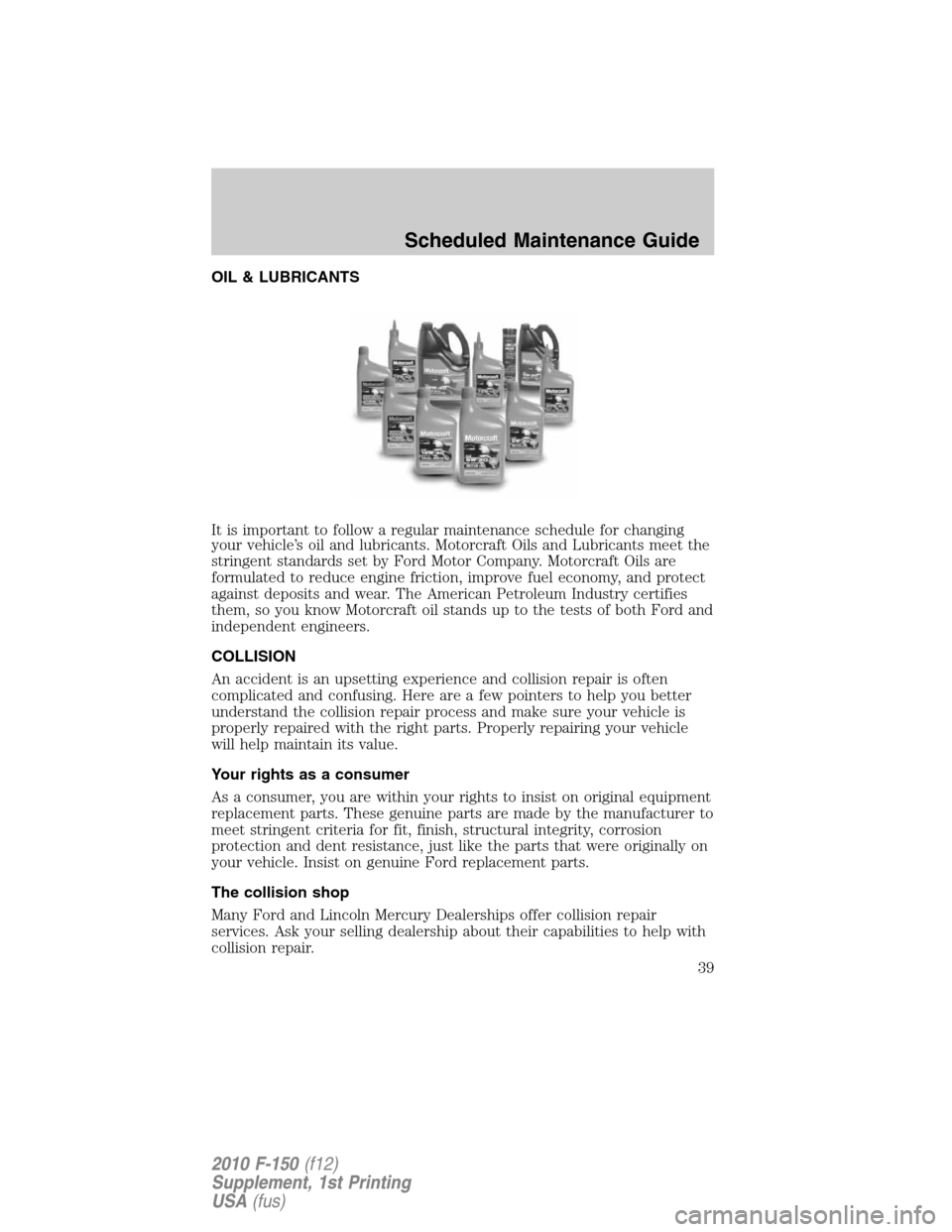
OIL & LUBRICANTS
It is important to follow a regular maintenance schedule for changing
your vehicle’s oil and lubricants. Motorcraft Oils and Lubricants meet the
stringent standards set by Ford Motor Company. Motorcraft Oils are
formulated to reduce engine friction, improve fuel economy, and protect
against deposits and wear. The American Petroleum Industry certifies
them, so you know Motorcraft oil stands up to the tests of both Ford and
independent engineers.
COLLISION
An accident is an upsetting experience and collision repair is often
complicated and confusing. Here are a few pointers to help you better
understand the collision repair process and make sure your vehicle is
properly repaired with the right parts. Properly repairing your vehicle
will help maintain its value.
Your rights as a consumer
As a consumer, you are within your rights to insist on original equipment
replacement parts. These genuine parts are made by the manufacturer to
meet stringent criteria for fit, finish, structural integrity, corrosion
protection and dent resistance, just like the parts that were originally on
your vehicle. Insist on genuine Ford replacement parts.
The collision shop
Many Ford and Lincoln Mercury Dealerships offer collision repair
services. Ask your selling dealership about their capabilities to help with
collision repair.
Scheduled Maintenance Guide
39
2010 F-150(f12)
Supplement, 1st Printing
USA(fus)
Page 41 of 57
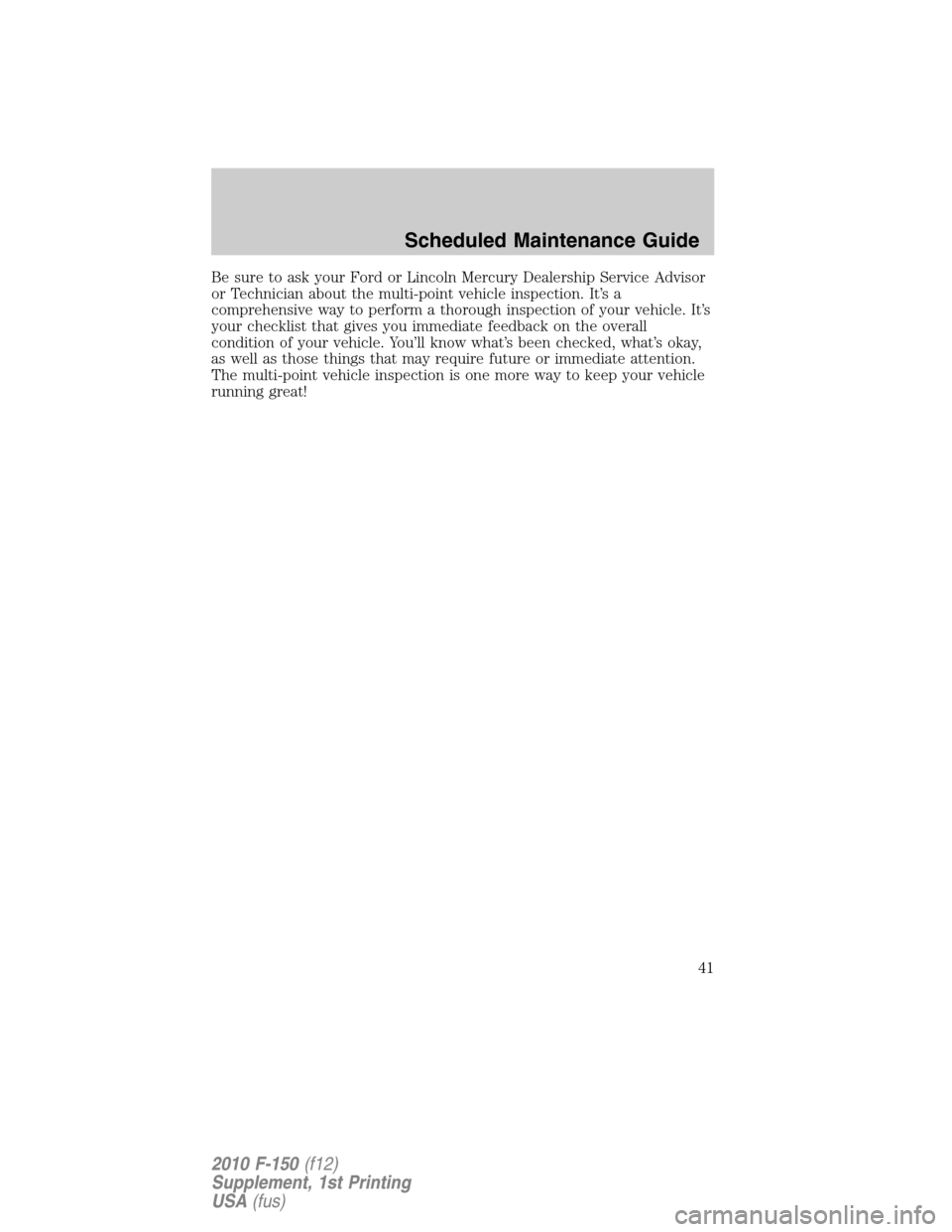
Be sure to ask your Ford or Lincoln Mercury Dealership Service Advisor
or Technician about the multi-point vehicle inspection. It’s a
comprehensive way to perform a thorough inspection of your vehicle. It’s
your checklist that gives you immediate feedback on the overall
condition of your vehicle. You’ll know what’s been checked, what’s okay,
as well as those things that may require future or immediate attention.
The multi-point vehicle inspection is one more way to keep your vehicle
running great!
Scheduled Maintenance Guide
41
2010 F-150(f12)
Supplement, 1st Printing
USA(fus)
Page 53 of 57

ITEMS NEEDING SPECIAL ATTENTION
If you operate your Ford/Lincoln/Mercury vehicleprimarilyin one of the
more demandingSpecial Operating Conditionslisted below, you will
need to have some items maintained more frequently. If you only
occasionallyoperate your vehicle under these conditions, it is not
necessary to perform the additional maintenance. For specific
recommendations, see your Ford or Lincoln Mercury Dealership Service
Advisor or Technician.
Towing a trailer or using a camper or car-top carrier
Every 60,000 milesChange transfer case fluid
Extensive idling and/or low-speed driving for long distances
Inspect frequently, service as
requiredReplace cabin air filter
Every 200 hours of useChange engine oil
Every 5,000 milesInspect brake system
Lubricate control arm and steering ball joints if equipped
with zerk fittings
Every 60,000 milesReplace spark plugs
Change transfer case fluid
Operating in dusty conditions such as unpaved or dusty roads
Inspect frequently, service as
requiredReplace engine air filter
Replace cabin air filter (if equipped)
Every 5,000 miles or 6 monthsInspect and lubricate U-joints
Every 60,000 milesChange transfer case fluid
Scheduled Maintenance Guide
53
2010 F-150(f12)
Supplement, 1st Printing
USA(fus)